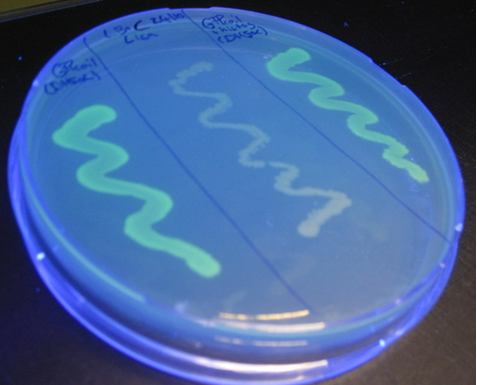Team:Wageningen UR/Journal/week26
From 2012.igem.org
(→Week 26: 22 october - 28 october) |
(→Week 26: 22 october - 28 october) |
||
| Line 36: | Line 36: | ||
''25 October'' | ''25 October'' | ||
| - | Again colonies had grown on the negative control plate, so ran a huge colony PCR on both 23-10 and 24-10 transformant colonies. | + | Again colonies had grown on the negative control plate, so ran a huge colony PCR on both 23-10 and 24-10 transformant colonies: |
| + | |||
| + | [[File:KeesvanderArk_loading_the_PCR.jpg|500px|thumb|left|Kees van der Ark loading the PCR machine with nearly 100 samples.]] | ||
| + | <br/><br/><br/><br/><br/><br/><br/><br/><br/><br/><br/><br/><br/><br/><br/><br/><br/><br/><br/><br/><br/><br/><br/><br/> | ||
<br/><br/> | <br/><br/> | ||
Wouter went to the Electron Microscope and checked whether the CCMV_NEG VLP batches contained VLPs. He also checked the sample that was loaded with iron. | Wouter went to the Electron Microscope and checked whether the CCMV_NEG VLP batches contained VLPs. He also checked the sample that was loaded with iron. | ||
Revision as of 15:25, 26 October 2012
Week 26: 22 october - 28 october
CCMV
22 October
Colony PCR on transformants.
Inoculated 10 mL of LB with three Top10 colonies and one DH5A colony.
23 October
Miniprepped the grown cultures and sent them for sequencing.
Digested the miniprepped plasmids with XbaI and SpeI.
Digested the IPTG + RBS biobrick with PstI and SpeI.
Ligated the CCMV_COIL fragment into the IPTG + RBS backbone and transformed into both DH5Alpha and Bl21 cells.
Plated transformation mixtures on ampicillin plates.
24 October
Colonies had grown on the negative control plate, so replated the transformation mixtures on kanamycin plates.
Loaded CCMV_NEG VLPs with iron.
25 October
Again colonies had grown on the negative control plate, so ran a huge colony PCR on both 23-10 and 24-10 transformant colonies:
Wouter went to the Electron Microscope and checked whether the CCMV_NEG VLP batches contained VLPs. He also checked the sample that was loaded with iron.
Only the untreated sample contained a small number of VLPs.
GFP modification
22 October
- sent bricks BBa_K883704 and BBa_K883705 in for sequencing (single read using the reverse sequencing primer)
-> the bricks have the expected sequence
- seperated colonies containing BBa_K883700 and BBa_K883701 (GFPcoil and GFPcoil with a His tag in pSB1C3) from the plate of 21.october a second time
23 October
- colony PCR on the seperated colonies containing the faulty biobricks BBa_K883700 and BBa_K883701 to check wheather there are colonies present with the correct insert
-> there was no insert present in the picked colonies
- grow batches BBa_K883702 in BL21, BBa_K883703 in JM109, BBa_K883704 in DH5α, BBa_K883705 in DH5α
24 October
- plate BBa_K883702 in BL21, BBa_K883703 in JM109, BBa_K883704 in DH5α, BBa_K883705 in DH5α on plates containing IPTG together with a control that does not produce fluorescence and incubate over night
-> slight fluorescence could be seen when comparing to the control
- checked fluorescence of JM109 cultures (from a plate) containing BBa_K883702 and BBa_K883703 with fluorescence microscopy
-> fluorescence could be seen in both cultures; a negative control (JM109 without a GFP encoding plasmid) showed no fluorescence; the positive control (JM109 containing Bba_I13522 - GFP with a constitutive promoter) showed strong fluorescence

Figure 4: fluorescence microscopy pictures of a negative control (JM109 without a GFP encoding plasmid); JM109 cultures containing the bricks BBa_K883702 GFP-coil and BBa_K883703 GFP-coil with His tag and a positive control (JM109 containing Bba_I13522 - GFP with a constitutive promoter). (left picture shows a picture of the same sample using light microscopy) '
25 October
- checked fluorescence of BL21 containing BBa_K883702 in, JM109 containing BBa_K883703, DH5α containing BBa_K883704 , DH5α containing BBa_K883705 from the batch of 23. October before induction with IPTG as well as from a plate containing IPTG (grown overnight) by fluorescence microscopy (also a positive control was included: JM109 containing Bba_I13522 - GFP with a constitutive promoter)
-> fluorescence could be measured for all the samples taken from the plate. Prior induction no or almost no fluorescence could be seen. The positive control showed again strong fluorescence.

Figure 5: fluorescence GFPcoil + IPTG induced promter in pSB1AK3 in BL21, GFPcoil + His tag + IPTG induced promter in pSB1AK3 in JM109, BBa_K883704 in DH5α, BBa_K883705 in DH5α measured with fluorescence microscopy. On the right side: before induction (sample taken from liwuid medium); on the left side: after induction with IPTG (sample taken from a plate) - of each sample a picture was taken once with light microscopy and once with fluorescence microscopy'
- inducing DH5α containing BBa_K883704 with IPTG and check for changes in fluorescence in time for about 1 hour
-> no changes could be seen during that time
CCMV K-coil frameshift correction
The PCR products of last week and a pSB1C3 backbone (RFP expression) were digested with EcoRI and SpeI for 30 min at 37°C + 20 min heat inactivation. Subsequently both samples (wt and Δ26) were ligated in 3:1 ration into the pSB1C3 backbone. We transformed electrocompetent E.coli (strain DH5α) with the ligation mixtures. This transformation approach allows a red-white screening. Next morning several colonies were present on both agar plates. But a colony PCR revealed that our desired construct are not present.
A second attempt also failed showing no colonies for both constructs, but red colonies on the positive control (transformed with pSB1C3 expressing RFP). Unfortunately no further experiment was done.
PLRV
We continued our VLP formation attempt with the purification protocol. On thursday, we went to the Wageningen Electron Microscropy Centre across town to see if we had any PLRV VLPs. We couldn't find any.
The sample from the adjusted protocol (skipped a washing step for fear of losing product) was too polluted to see anything. The normal sample contained many vesicles, but no VLPs.
[previous week]
 "
"














